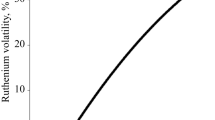Abstract
The precipitation characteristics of palladium (Pd) from a simulated radwaste solution by ascorbic acid was investigated. Pd was selectively precipitated by the reduction reaction of Pd with ascorbic acid. When the nitric acid concentration in the 8 component system was below 2.0 M, Pd over 99.5 % was selectively precipitated at an ascorbic acid concentration above 0.06 M, while other elements mainly remained in solution. The precipitation yield of Pd by ascorbic acid decreased with the increase of the nitric acid concentration.
Similar content being viewed by others
References
AL-bazi, S. J. and Chow, A., “Platinum Metals-Solution Chemistry and Separation Methods (Ion Exchange and Solvent Extraction,”Talanta,31(10A), 815 (1984).
Creutz, C., “The Complexities of Ascorbate as a Reducing Agent,”Inorg. Chem.,20, 4449 (1981).
Kim, E. O., Yoo, J. Y. and Choi, C. S., “Removal of Palladium Precipitate from a Simulated High-Level Radioactive Liquid Waste by Reduction by Ascorbic Acid,”Radiochimica Acta,80, 53 (1998).
Kondo, Y. and Kuboto, M., “Precipitation Behavior of Platinum Group Metals from Simulated High Level Liquid Waste in Sequential Denitration Process,”J. Nucl. Sci. Technol.,29(2), 140 (1992).
Kubota, M. and Fukase, T., “Formation of Precipitate in High-Level Waste from Nuclear Fuel Reprocessing,”J. Nucl. Sci. Technol.,17, 783 (1980).
Lee, S. S., Kang, B. G. and Kim, J. W., “A Study of Separation and Recovery of Valuable Metals from Fly Ash,”HWAHAK KONGHAK,32, 300 (1994).
Lide, D. R., “CRC Handbook of Chemistry and Physics,” 72nd Edition, CRC Press Inc., Boston (1991).
McDuffie, H. F., “Recovery of Nonradioactive Palladium and Rhodium from High-Level Radioactive Wastes,” ORNL/TM-6654 (1979).
Myasoedova, G. V. and Savvin, S. B., “New Chelating Sorbents for Noble Metals,”Talanta,32(12), 1105 (1985).
Roberts, F. P., “The Radiation Characteristics of Reactor Produced Rhodium, Palladium, Ruthenium and Technetium,” BNWL-1693 (1972).
Sakurai, H. and Hirokawa, K., “Precipitation Behavior of Metallic Palladium & Platinum in Aqueous Solutions,”BUNSEKI KAGAKU,45(8), 795 (1996).
Author information
Authors and Affiliations
Corresponding author
Rights and permissions
About this article
Cite this article
Lee, S.H., Kim, K.R., Shon, J.S. et al. Precipitation characteristics of palladium from a simulated radioactive liquid waste by Ascorbic Acid. Korean J. Chem. Eng. 16, 166–169 (1999). https://doi.org/10.1007/BF02706831
Received:
Accepted:
Issue Date:
DOI: https://doi.org/10.1007/BF02706831



